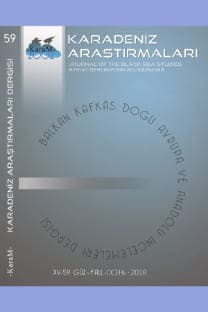KARADENİZ'DE ÇAY VE FINDIK ÜRETİMİNDE GÖÇMEN İŞGÜCÜNÜN ETNİKLEŞME SÜREÇLERİ
Son yıllarda dünyada ve Türkiye’de artan mülteci ve göçmen sorunla- rının beraberinde getirdiği sorunlardan biri de enformel sektörlerde kayıt dışı çalışan göçmen işgücünün yaygınlaşmasıdır. Özellikle Tür- kiye’de tarım sektörü aile emeğine dayalı üreticilik yerine Güneydoğu, Gürcistan ve Suriye gibi çeşitli bölge ve ülkelerden gelen ucuz işgücü- nün giderek önem kazandığı yeni bir karakter kazanmaktadır. Bu du- rum Türkiye’nin diğer bölgelerinde olduğu gibi Karadeniz’de çay ve fındık tarımının işgücü özelliklerinde büyük bir dönüşümü berabe- rinde getirmektedir. Bölge dışından gelen düşük ücretlerle çalışan göçmen işgücünün üretimde önemi artarken aynı zamanda Karade- niz’in tarımsal alanları Kürtler, Gürcüler ve Suriyeliler gibi farklı ülke ve etnik aidiyetlerden gelen işgücünün bir araya geldiği yerler haline gelmektedir. Çalışmada bu işgücünün işçileşme ve etnik temas, karşı- laşma ve ayrışma süreçleri arasındaki karşılıklı etkileşimler ele alın- mıştır. Sınıfsal konumlar kadar etnikleşme süreçlerine bağlı algılar, söylem ve pratiklerin de göçmen işgücünün içinde bulunduğu, maruz kaldığı dezavantajları şekillendirdiği saptanmıştır.
Anahtar Kelimeler:
Göçmen işgücü, sınıf ilişkileri, etnikleşme süreç- leri
Ethnicization Processes of the Migrant Workforce in Production of Tea and Hazelnut in the Black Sea Region
One of the main problems brought by the increasing refugee and immigration problems in the world and Turkey in recent years is the widespread migration workforce working in informal sectors. Espe- cially in Turkey, the agriculture sector is gaining a new character where cheap labor from various regions and countries such as South- east, Georgia and Syria is increasingly important, instead of producing based on family labor. This situation brings about a great trans- formation in the labor characteristics of tea and hazelnut farming in the Black Sea as it is in other parts of Turkey. While the cheap migrant labor is increasing in production the agricultural areas of the Black Sea are becoming places where different countries and ethnic belong- ings like Kurds, Georgians and Syrians come together. In this study, the interactions between labor and ethnic contact, encounter and dissociation processes of this workforce were discussed. It has been found that perceptions, discourses and practices related to the pro- cesses of ethnicity as well as class positions shape the disadvantages that the migrant workforce is exposed to.
Keywords:
Migrant workforce, class relations, ethnicization proces- ses.,
___
- ANTHIAS Floya (2001). "The Concept of ‘Social Division’and Theorising Social Stratification: Looking at Ethnicity and Class." Sociology 35.(4): 835-854.
- ANTHIAS Floya ve Nira Yuval-Davis (2005) Racialized boundaries: Race, Nation,Gender, Colour and Class and The Anti-Racist Struggle. London: Routledge.
- BALIBAR Etienne ve Immanuel WALLERSTEIN (1995). "Irk Ulus Sınıf Belir- siz Kimlikler”,çev. Nazlı ÖKTEN. İstanbul: Metis Yayınları.
- BONACICH Edna (1972). “A Theory Of Ethnic Antagonism: The Split Labor Market” American Sociological Review, Vol. 37, (5): 547-559.
- BONACICH Edna (1999) "Class Approaches to Ethnicity and Race." Critical Sociology 25, (2/3): 166-194.
- CASTELLS Manuel (1975) ‘Immigrant Workers and Class Struggle in Advan- ced Capitalism’, Politics and Society, 5 (1), 33-66.
- CASTELLS Stephen ve Mark J. MİLER (2008) Göçler Çağı: Modern Dünyada Uluslar arası Göç Hareketleri, İstanbul: İstanbul Bilgi Universitesi Ya- yınları.
- COX Oliver (1948) “Caste, Class and Race”, New York: Monthly Review. ERIKSEN Thomas Hylland (2004) Etnisite ve Milliyetçilik: Antropolojik Bir Bakış, Çev. Ekin Uşaklı, İstanbul: Avesta Sosyal Bilim.
- GAMBETTİ Zeynep (2007) “Linç Girişimleri, Neoliberalizm ve Güvenlik Devleti”, Toplum ve Bilim, 109: 7-34.
- HANDELMAN Don (1977) "The Organization of Ethnicity” Ethnic Groups. An International Periodical of Ethnic Studies, 1.3: 187-200.
- HAYATA DESTEK DERNEĞİ (2014) Mevsimlik Gezici Tarım İşçiliği 2014 Araştırma Raporu, İstanbul.
- ISSN: 2536-5126
- Yayın Aralığı: Yılda 4 Sayı
- Başlangıç: 2004
- Yayıncı: Osman Karatay
Sayıdaki Diğer Makaleler
DOĞU KARADENİZ BÖLGESİNDE BALIKÇILIK
GÜRCİSTAN İLE TÜRKİYE’NİN TİCARİ İLİŞKİSİ VE ARTVİN’DEKİ TİCARETE ETKİSİ
DOĞU KARADENİZ’İN KENTLEŞME YAPISI VE SORUNLARI
Korkmaz YILDIRIM, Yunus Emre AYNA
TÜKETİCİLER COĞRAFİ İŞARET İÇİN DAHA FAZLA ÖDEMEK İSTER Mİ? ARTVİN BALI ÜZERİNE BİR ARAŞTIRMA
KENTSEL ALANDA MEKÂNSAL DÜZENLEME VE KADININ KENT KULLANIM HAKKI: HOPA ÖRNEĞİ
YENİDEN ÖLÇEKLENME BAĞLAMINDA DOĞU KARADENİZ BÖLÜMÜNDE SOSYO-İKTİSADİ VE SÖYLEMSEL MEKÂN ÜRETİMİ
Muhammet Ali SAĞLAM, Onur ACAR
KARADENİZ'DE ÇAY VE FINDIK ÜRETİMİNDE GÖÇMEN İŞGÜCÜNÜN ETNİKLEŞME SÜREÇLERİ
